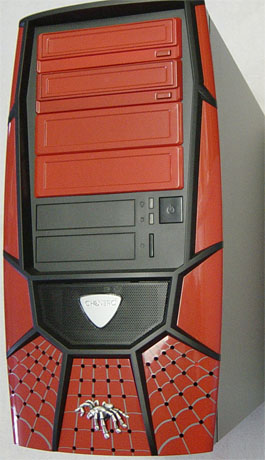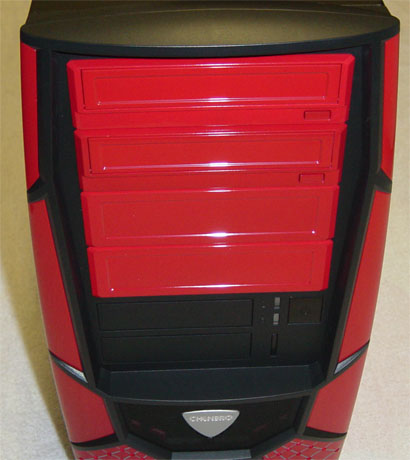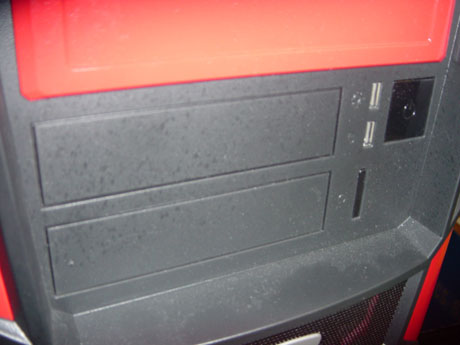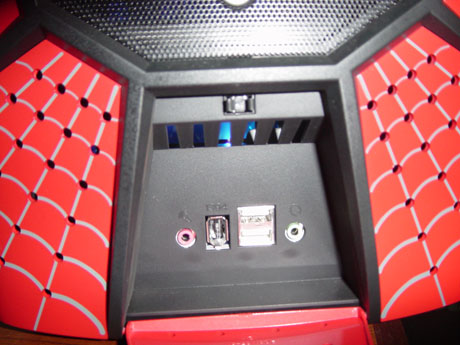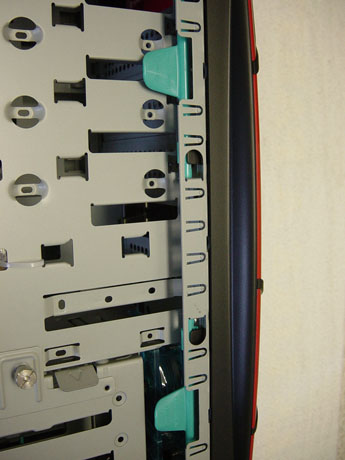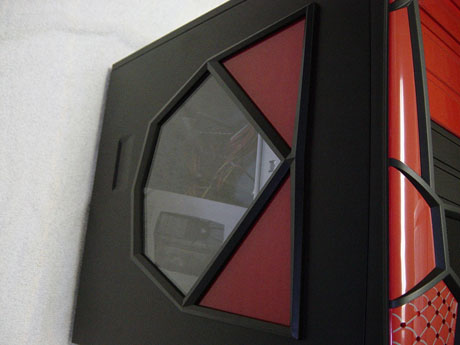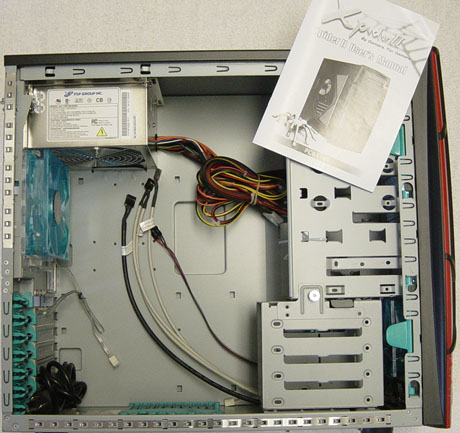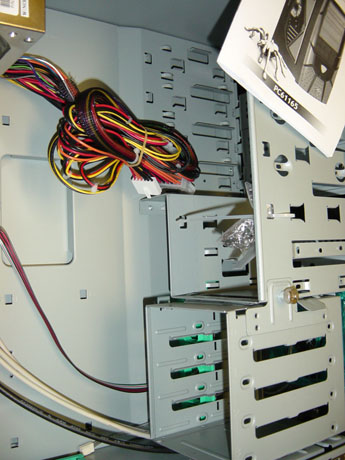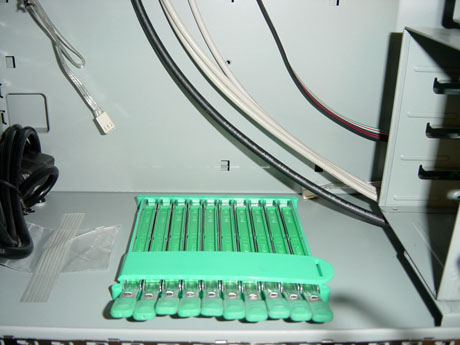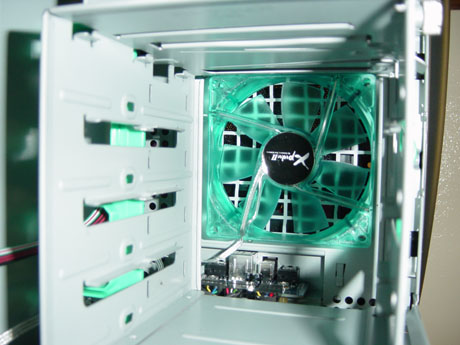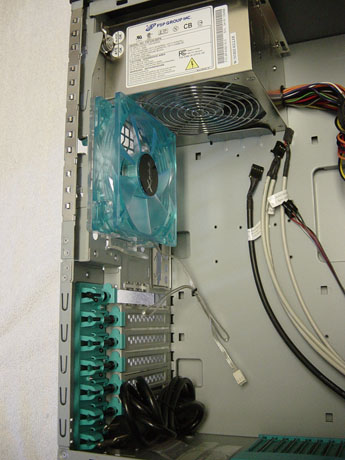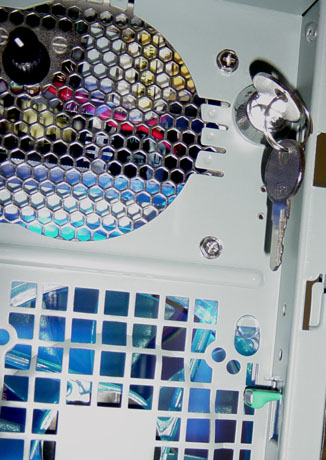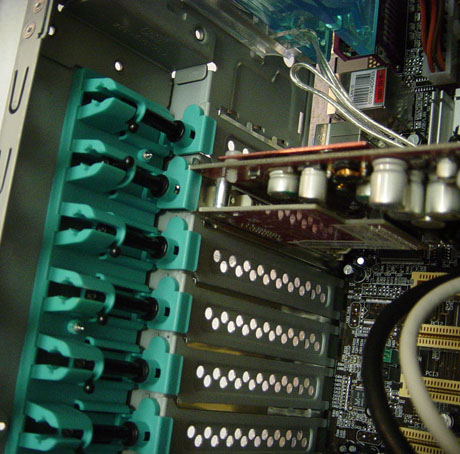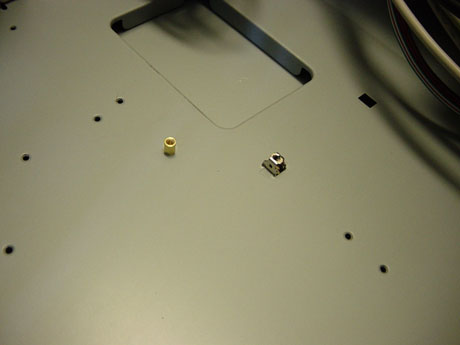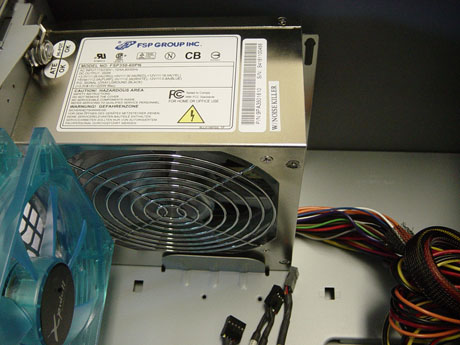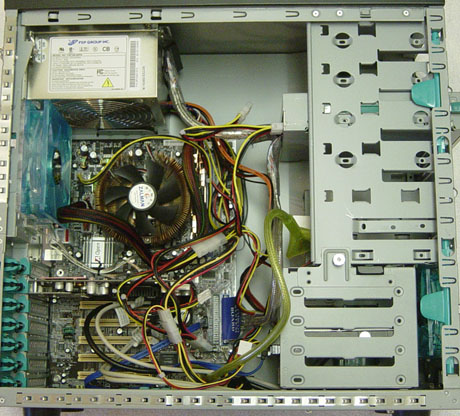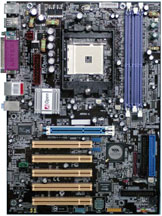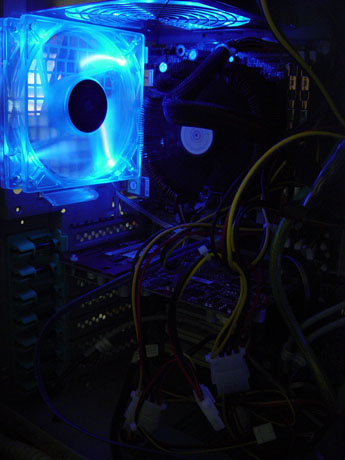
Original Link: https://www.anandtech.com/show/1421
Introduction
| Quick Look | |
| Chenbro Xpider II | The Good |
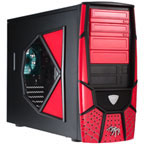 |
+ One 120mm LED case fan, one 92mm + 350W Power Supply + Removable 3-1/2" drive bay + Tool-less side and front panel |
| The Bad | |
| - No removable motherboard tray - Not completely tool-less design - Limited HDD bays |
|
Chenbro is a 20-year-old name in the computer case industry. It has been manufacturing PC, server and rackmount cases since then and has a few other things on its list of achievements. Chenbro was the first to bring the tower case design to the market and they also claim to have implemented the first removable motherboard tray.
Along with those great feats, Chenbro has many other things under its belt such as about 180 mechanical design patents, and with over 700 employees across the world, Chenbro is one of the biggest manufacturing companies in the world.
With 20 years of experience, we thought Chenbro had plenty of time to realize the best and worst in PC case design. They have released a few gaming chassis in the past few years, which we have not had the pleasure to look at until now.
Chenbro was kind enough to send us a sample of their Xpider II, which has been out on the market for a while now. With all cases, we took the Xpider II apart to see what makes it stand out from the rest. Take a look at what we found.
More information is available on the Xpider II at Chenbro's website.
External Design
We've seen many manufacturers that will try to put more time and effort into designing a good looking case while paying less attention to the internal features and functionality. We have seen this happen and we have usually seen these products do worse than those that are decent looking with great features.The front of the case is made up of a custom molded bezel, which gives it a look that says gaming all over it. The Xpider II does have a spider theme, but it has been implemented in a clean and meaningful way. The bezel is also unique, since most of the cases that we look at are usually based on another design.
The drive bay covers are painted in one of the 4 available colors to match the rest of the case. The top two 5-1/4" drive bay covers are optical drive bezels, which take away that awful mismatch of color when using a beige colored drive. The bottom two 5-1/4" drive bay covers are the bare type that can be easily removed.
At mid-height are the 3-1/2" drive bays with simple black bay covers to make them blend into that area. To the right of the bays are the power and HDD LED's, and the large square power button to the right of those. Directly below those is the reset button, which is a narrow vertical shape that is difficult to press if you are one with large fingers. It does, however, conform to the shape of the power and HDD LEDs directly above it.
At the bottom of the Xpider II is a flip-down door, which hides the audio, USB, and FireWire ports. The door itself is painted with a web design to match the bottom 1/4 of the case bezel. It also has holes that allow the front mounted fan to pull air into the case.
Above that area is a black mesh metal grill, which is the main intake for this front mounted fan. It has an interchangeable shield shaped aluminum piece that shows off the Chenbro name. The replacement shield is made of a clear plastic and can be swapped out by removing the air filter on the backside of the case's bezel.
The bezel can only be removed by pulling the release clips on the inside of the case next to the drive bays.
The only other removable panel on the Xpider II is the left side panel for access to the case's internal components. Instead of thumbscrews being used to secure the panel to the Xpider II, Chenbro has implemented a mechanism that locks the panel in place easily.
The panel itself has a diamond-shaped window and is accented by red paint to continue the cases overall look.
Internal Design
Inside this gaming chassis, we found plenty of features that puts the Xpider II apart from the rest. Though its design is not completely tool-less, it has plenty of positive points to make up for that.We found the drive bays the most interesting out of the entire case. Chenbro makes use of drive rails for the 5-1/4" drive bays that snap-on to the drives easily and securely. There are four 5-1/4" drives in total, which is the standard for mid-tower chassis these days. The option to use screws is also given.
The 3-1/2" drive bays were something to look forward to when working with the Xpider II. There are three directly under the 5-1/4" bays, where two are meant for floppy drives. The third is reserved for a HDD that most likely will not be removed when working with the case.
Under those bays is the removable carriage for four more 3-1/2" drives. The carriage is held in place by a single thumbscrew and a metal stopper, which can be pushed down to remove the carriage. The carriage is guided in and out by machined tracks to keep it from moving about and damaging the drives. The drives, unfortunately, must be screwed into the carriage to secure them. We have seen many other cases like Thermaltake's Damier V6000A that uses drive rails for all of its bays to minimize tool usage.
The Xpider II comes with 5 pairs of drive rails (four 5-1/4" drives and one 3-1/2" drive), which are secured at the bottom of the chassis on the inside.
Case Fans
When it comes to gaming chassis, the most important features are those for cooling the installed hardware. The best games require the latest in computing technologies to perform their best and if not physically taken care of, those high end, hot running components could become damaged.This is where case fans come into play. Chenbro has decided to go with a combination of a 120mm and a 92mm LED fan to increase air flow as well as decrease the noise. We have found in the past that 120mm fans are much quieter than their smaller 92mm counterparts and felt Chenbro should have gone with a pair of 120mm fans instead.
The first fan, the 92mm, is mounted at the front of the Xpider II as an intake. It directs air at the HDD carriage, which we have seen happen in more than a handful of cases like Thermaltake's Damier V6000, SuperFlower's X-Mask, and NZXT's Guardian.
The second 120mm fan is mounted at the back of the case at the height of where the CPU would be to increase air flow over the CPU heatsink. This allowed the CPU to run much cooler than other cases.
A third fan would have been a great addition, for example, to exhaust air from those heat dispersing VGA cards, like the ATI 9700 Pro that we used in testing the Xpider II.
Update: We originally posted the first fan to be 80mm which was smaller than what was actually included, 92mm. Chenbro has contacted us on this issue to help us resolve this discrepency.
Construction
The Chenbro is made of the typical steel still used in many cases today. We would like to see more manufacturers make use of aluminum, but we realize that it comes with a price. Chenbro, however, has constructed the Xpider II in a way that would make us forget aluminum, if only for a while.Sharp edges are the main concern of buyers who consider steel chassis. Sharp edges can lead to cut wires, or even cut hands. Chenbro has done a great job in folding over and dulling those edges to keep the problem to a minimum.
As far as security features go, the Xpider II really only has one, and the way it is designed, it only needs one. Since there is no removable right panel, the only thing keeping strangers from fiddling with the insides of your case is the left panel. There is a key lock at the back of the case to secure the panel. No key, no access.
Since the releases for the front bezel are inside the case behind the left panel, that also cannot be removed.
Expansion
When it comes to gaming, chassis expandability is a feature that the case should definitely have. Chenbro has designed the Xpider II to allow four 5-1/4" drives and a total of seven 3-1/2" drives to be installed at one time. Though the case may become cluttered when packed with that much hardware, there is that potential to fill the Xpider II.The second area where expansion is most important is the add-on card area. Chenbro employed locking devices to secure add-on cards in place. We have seen better devices on many other cases. Thermaltake's Xaser III Skull had an interesting sliding clip that held add-on cards in place.
We had some trouble with our 9700 Pro card and the mechanism. Since the 9700 had a daughter card for the DVI output, it got in the way of the piece, which would wrap around the add-on card mount, keeping it from being locked. Thumbscrews would have sufficed for this application, since Chenbro did not really utilize a tool-less design throughout the Xpider II.
Motherboard Tray
One feature that is slowly becoming standardized in many cases is a removable motherboard tray. It makes replacing motherboards and add-on cards much easier when the components that you want to work with can be taken out of the rest of the chassis.We were disappointed to see the lack of a removable tray with the Xpider II being a gaming chassis. Most gamers like to swap out their old outdated hardware for the latest in technology to keep up with the latest in games, and a removable tray would have been a big hit with them.
The tray does have plenty of machined holes to mount various types of boards, though this is mainly an ATX case. And the Xpider II makes use of snap-on stand-offs to mount the motherboard. Again, screws are required, and are provided, but we would like to see Chenbro move to a more tool-free design with its products.
Installation
Installation of all components took no more than 15 minutes and since the Chenbro threw in a 350W power supply, a few minutes were shaved off that total installation time. We did swap out that power supply with our own test bed unit, the OCZ 520W PowerStream, for our benchmarks.The most time consuming part of the installation was screwing in the motherboard and HDD. We did spend a few minutes thinking about whether the VGA card would be safe in its slot without being securely mounted and decided to be careful with it.
Benchmarking
When benchmarking the Xpider II, we test the temperatures of key components including the actual CPU temperature, the actual temperature inside the heatsink, the temperatures of the DDR, Northbridge, Southbridge, HDD, PSU, and the ambient temperature inside the case, all during normal operation. For a system to operate efficiently, the components need to stay at a specified temperature to avoid system crashes, or worse, hardware damage. A well designed case should have an air flow system that is effective in keeping the hottest running components at a constant and stable temperature for optimal performance. During our testing, the PSU and CPU heatsink fans remain on to measure temperatures during normal system operations.AOpen AK86-L |
We took temperature readings of the components at 10 and 30 minutes of system operation time. When we first tested the Thermaltake Damier V6000A, we found the numbers to be much higher than we expected. We retested and found our results to be much closer to the actual expected numbers. Take a look at how the Chenbro Xpider II compares to the first case tested with our new test bed, the Thermaltake Damier V6000A.
| Chenbro Xpider II | |||||||||
| System On-Time | CPU | Heatsink | HDD | DDR | Northbridge | Southbridge | Power Supply | System Ambient | |
| 10 | 36 | 22.4 | 29.6 | 29.3 | 33.6 | 27.5 | 24.1 | 25.7 | |
| 30 | 45.2 | 29.5 | 31.1 | 30.4 | 34.2 | 28.6 | 26.8 | 26.4 | |
| Thermaltake Damier V6000A | |||||||||
| System On-Time | CPU | Heatsink | HDD | DDR | Northbridge | Southbridge | Power Supply | System Ambient | |
| 10 | 35.2 | 21.6 | 29.1 | 29.1 | 33.5 | 27.1 | 23.8 | 23.2 | |
| 30 | 43.6 | 28.4 | 30.2 | 30.1 | 33.9 | 28.4 | 26.4 | 25.8 | |
Since we retested the Damier, we could compare the temperatures of its benchmarks to those of the Xpider II. From the results, it is obvious that five 80mm fans are better than a 92mm paired with a single 120mm fan. CPU temperature readings were about 1 degree higher on the Xpider at 10 minutes of running time, and close to 2 degrees higher after 30 minutes. The other components followed with only a slight difference in temperature.
Though cooling is a major factor in choosing a good case, noise levels also affect the overall quality of the product. We tested the noise level of the Xpider II about 12" from the sealed case with the power supply and CPU fans turned off to reproduce the noise of the case alone. Since the test bed power supply and CPU heatsink fan were turned off, we were able to compare the Xpider II to the results of previous cases that we have tested.
| Case | dBA |
| Chenbro Xpider II | 45 |
| Thermaltake Damier V6000A | 53 |
| Super Flower X-Mask | 51 |
| Lian Li PC-V1000 | 46 |
| Opus Technologies MT-200 | 56 |
Though the V6000A had five fans, it was much quieter than the VM3000A, which had only four fans. Thermaltake decided to use variable speed fans as well as various models of fans, all having different output ratings with the V6000A instead of using all equally powerful fans throughout the chassis. This variance in output produced less noise, since only certain fans were required to operate at higher speeds than the others.
Final Thought
In the end, what really makes a good gaming chassis? We believe a worthwhile product should include a tool-less design, greater possibilities for expansion, ample drive bays, and regardless of any other feature, a removable motherboard tray. We mentioned earlier that gamers, more than any other end user, swap out hardware to keep up with changing technologies. This creates the need for a case that will allow them to do this without running into messy wiring or cramped space inside the case.Though Chenbro does not include many of these features in their Xpider II, its performance comes close to a great gaming chassis as far as heat and noise benchmarks go. Compared to the Thermaltake Damier V6000A, the Xpider II performed at just about the same level. It is surprising, since the Damier has three more fans than the Xpider II.
The Xpider II's use of drive rails was also a great choice, but would have been even better had it been implemented in the bottom six 3-1/2" drive bays. And Chenbro's add-on card securing device was an excellent idea, but could be improved to work with the varying designs of add-on cards.
With the combination of these features, we conclude that the Xpider II is at par with the other mid-range themed cases, like the X-Mask and the Guardian, but a price tag of around $80 may seem a bit on the expensive side compared to those two.

